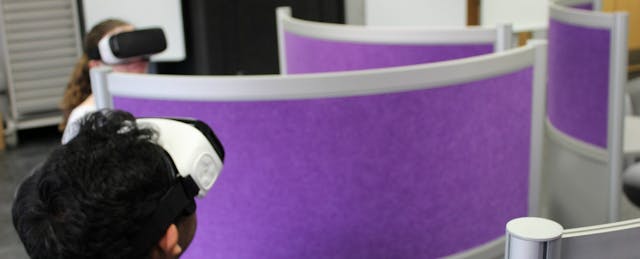Agriculture professors like to take students on “crop walks” to teach them how to spot certain plant diseases, but it’s an activity that can only be done during the right season. So when Melanie Miller-Foster, an agriculture professor at Pennsylvania State University, started thinking about using 360-degree VR headsets in her class, she decided to try to simulate crop walks year-round.
Then she realized one challenge of the technology: In a 360-degree video, the professor who recorded the footage can’t control where in the scene students will look at any given time. The view changes as the viewer turns their head. “We have this thing over here that we want everyone to see,” Miller-Foster says, “so how do we make sure everyone sees it?”
They soon realized, though, that this feature of the technology could be a benefit. Forcing the student to find the right part of the image makes the educational experience more interactive than passively watching. They added text instructions to the footage so that when students look down, they see directions for what they need to find next, or clues to guide them as the scene changes.
“We’re setting up the opportunity for you to discover it,” says Daniel Foster, an associate professor of agriculture, economics, sociology, and education at Penn State. “We hear a lot about student-centered instruction and trying to move away from teacher-centered models,” he adds. “It’s ok to say it’s going to be for individualized learners doing it at their own time at their own pace.”
The professors can soon use a new facility at Penn State set to open in a few weeks. It’s called the Immersive Experiences Lab, and it will feature a series of desks arranged in a pinwheel of cubicle-like desks arranged in a circle. The goal is to allow students wearing headsets to be separated by furniture so they won’t accidentally run into each other as they turn to look around in an immersive video.

“When you have a headset on, it’s a relative vulnerable position you’re in—you’re essentially blindfolded,” says Kyle Bowen, director of education technology services for the university. “You’ve probably heard the saying ‘herding cats.’ In this case you’re herding blind cats.”
Bowen says his team is working to create software that can trigger several 360-degree videos to start exactly at the same time, so that a professor and students will all experience a similar scene, even as each can look in different directions. “It’s somewhat like if you imagine going on a safari, and you’re all riding on the same truck,” he says. “You can look wherever you want to, but you’re all riding in the same direction.”
Professors elsewhere are working on similar challenges of incorporating the new technology into the classroom. Derek Ham, an assistant professor of graphic design at North Carolina State University who works with the Experience Design Lab there, says that when working with a group of students, they usually don’t have enough cellphones connected to Google Cardboard to give one to every student. So he designs “waiting activities” to keep students engaged even when they are not looking at an immersive video. For example, one student might prepare a critique of another student’s design while they wait for a turn to see the next student-created project.
Back at Penn State, Miller-Foster says her ideal is for immersive videos to better prepare students for real-world activities. “One of the functions of my job is to take students on study-abroad trips,” she says, usually to Latin America. But many students are reluctant to make the voyage.
“We’re trying to combat some negative perceptions of study abroad,” she says. “When you put those glasses on it transports you to another space. If we can give students a taste of going to another place, I hope it helps encourage them to do the real thing.”
Those trips, she says, end up being about so much more than can be replaced by a video. “Students experience a whole lot of growth and change on these trips,” she says. “We have to have a variety of experiences to help students make the leap.”
Of course, it's still unclear how widely this technology will catch on. "We’re still very much in the novelty phase," says Foster. "I'm not trying to oversell it. This is another tool to add to the instructor’s toolbox to meet the students’ needs."


